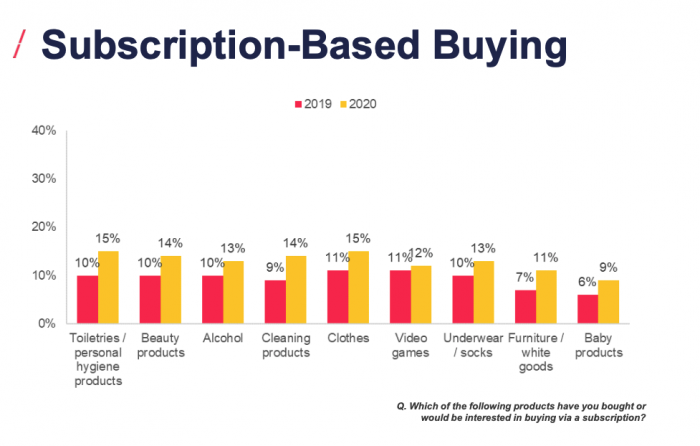Subscription services and products were already popular with consumers, even before the massive surge that we’ve seen over the last twelve months. From food boxes and trendy beers, video and music streaming, to regular supplies of toiletries and flowers, there has been a huge increase in the number of subscription services available. They make our lives that bit easier: we pay a little bit more for peace of mind, to remove thinking time when there is too much choice (often on stuff we don’t really care about), or to give us access to more options without having to own them.
From a personal point of view, I have CD and magazine subscriptions – a little bit of joy through the post box every month; I get Harry’s top-quality razors as and when I need them; and I have video and music options from Amazon, Netflix and Apple+ on tap. And it doesn’t feel like I over-pay for any of them.
Subscriptions and COVID
When COVID-19 hit, the world went subscription mad. With everyone from small beer producers to coffee grinders, toothpaste producers and Michelin-starred restaurants now offering subscription options, it has been a boom time. And it has come at the most convenient time, when we can’t really get out and about to shop as easily as we normally would.
Statistics from the DMA show that customers’ interest in subscription-based buying has increased significantly compared to a year ago: with customers buying more personal hygiene products (15%), clothes (15%), beauty and cleaning products (14%) and also alcohol (13%) via a monthly subscription in 2020 – all notable increases on 12 months before – while in 2020, 45% of consumers streamed live television at least weekly, up from 20% in 2017.

I recently chaired an event on this topic as part of my role on the DMA’s Customer Engagement Campaign. The event shared some research around the surge in subscriptions during the last 12 months, driven by our change of behaviour in lockdown. We had a discussion with Pact Coffee, who provide fresh coffee by subscription; someone who has marketed everything from hosiery to DVDs to wine by subscription; and Santander Bank, who are using AI and machine learning to remind customers of subscriptions they are paying for and may have forgotten about.
A subscription is for life… or is it?
There were a number of interesting points that came out in the discussion. First of all, while this surge has been great for subscription businesses, it creates a challenge: what happens when we return to normal? Will people stop using subscriptions as much and create a retention challenge for the brands? Clearly now is the time to be thinking about this and offering the flexibility that will be needed to retain as many customers as possible.
Which brought us on to a couple of other topics. First of all, transparency. This was noted not only in the research but also came through very strongly from the panel: being open and honest with the end customer is vital. Pact goes as far as to send emails just before each delivery to make sure customers know what they’re ordering. This gives them the chance to defer that month’s order, choose something different or even add to the order being dispatched. These are sent out every single day and over 60% of the emails get some form of interaction. They firmly believe that this openness and choice builds loyalty over time. Gone are the days of subscription services using inertia as their main retention policy!
Finally, given how many different subscription options are now available, how do brands set themselves apart? One of the interesting things the research showed was how much green credentials and inclusiveness play a part in consumer decision-making. It isn’t enough to have a great product (although that helps), it is also important to be able to verify the source of the products, the provenance and where possible the benefits not just to the consumer but also to society as a whole. Pact, for example, pays a guaranteed amount above market rate for its coffee to ensure that its producers are being treated fairly.
Data and subscriptions
From a data perspective, subscriptions are great. In most cases something is being delivered to the person’s home so you already have access to a name, address, email and other identifiers. This data is all gathered legitimately and hopefully permissioned for other engagement. In addition, every transaction is known, as is who defers, how often, who orders more product, how people were recruited, on what offer and who cancels and why.
Such a huge amount of valuable, usable data. Coupled with external data (legally of course), this can be used to create segmentation solutions, attrition models, up-sell and cross-sell models and much more. With all the rich data available, there is no excuse to not know the end customer and also understand how to engage and excite them.
The pandemic didn’t create the subscriptions market, but it has had a positive impact. But there is work to do as and when our lives return to normal. Using the massive amount of data that subscription models generate will be central to understanding the customers that have been acquired, who can be retained in the future and how.



